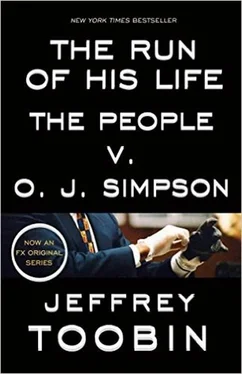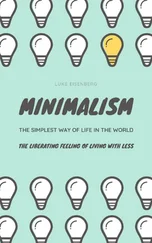Ito floundered. Courtroom discipline fluctuated according to the judge’s press clippings. When, as happened periodically, a big story in the Los Angeles Times or on one of the networks chided him for letting the case drag on, the judge would snap to attention for a day or two, refusing to hold sidebars and generally pushing things along. His resolve would then fade until the next critical story. After Newsweek put Ito’s picture on the cover under the headline WHAT A MESS, the judge lashed back at the press by permanently evicting two reporters from the courtroom, ostensibly for talking. Gale Holland of USA Today and Kristin Jeannette-Meyers of Court TV paid the price for Ito’s pique. When The New York Times published a hostile editorial entitled “Bankers’ Hours for the O.J. Case?” Ito lengthened the court day. Fundamentally, though, nothing much changed.
The families of the victims dealt with the stress in strikingly different manners. For many months, the Goldman family simply bore witness at the trial and said little in public. Denise Brown used the occasion of the trial to embrace the cause of domestic violence. She and her family created the Nicole Brown Simpson Charitable Foundation, devoted to the issue of spousal abuse. It was launched at a press conference at the Rainbow Room in New York, sponsored by No Excuses sportswear, best known previously for some scandal-scarred spokeswomen, among them Donna Rice, Marla Maples, and Paula Jones. As the first president of the foundation, the Brown family named Jeff C. Noebel, a forty-year-old Dallas businessman who was awaiting sentencing for lying to federal authorities in a savings-and-loan scam and who had been named in a domestic-violence restraining order for posing a “clear and present danger” to his estranged wife and two children. (Noebel stepped down when these facts about his past became public.)
Their greatest humiliation, the jurors remembered later, came right before bed. At 11:00 every night, one of the deputy sheriffs would walk around the fifth floor of the Inter-Continental Hotel, knock on the jurors’ doors, and demand their room keys. This ceremony went on every night for months before anyone even asked about it. This was how the jurors behaved-trusting, accepting, even passive about the many embarrassments of their quasi-custodial living arrangements. Finally, someone worked up the nerve to ask why they had to surrender their keys for the six and a half hours until the deputies returned to wake them up.
“It’s so you don’t go into each others’ rooms,” the sheriff’s spokesman replied.
That was that. The jurors were to be trusted to decide whether O.J. Simpson murdered two human beings but not to sleep with the keys to their own rooms. As usual, there was no protest, and the jurors continued to yield the keys until their last night in confinement. As with so many petty insults, the jurors lived with this one, too.
By summer, they were struggling. Twelve jurors and twelve alternates had reported for sequestration under the twenty-four-hour-a-day supervision of the Los Angeles Sheriff’s Department on January 11. With the exception of occasional weekend outings-a much-enjoyed group ride on a blimp, a disastrous boat ride to Catalina Island, on which almost everyone got seasick-the jurors’ world was circumscribed by the courthouse and the Inter-Continental, about a mile away. Their rooms had no telephones or televisions. Deputy sheriffs dialed and monitored all telephone calls from a central “telephone room,” and screened newspapers for references to the case, clipping them out. Blockbuster supplied an unending stream of movies for the pair of “video rooms,” dubbed Cinema 1 and Cinema 2 by Judge Ito. The jurors ate their meals as a group. One night a week, from 7:00 to midnight, the jurors were allowed unsupervised conjugal visits with their spouses or significant others.
Not surprisingly, these arrangements produced immediate and lasting stresses on the jurors. The strain showed itself in trivial ways. Like summer campers (or, more relevant, prisoners) everywhere, the jurors complained about the food. As Armanda Cooley, who eventually became foreperson, once put it in a meeting with the judge, “Same thing, repetitious, too many particles walking, crawling, talking in the food.” Movie selection produced enduring tensions, as did movie-watching behavior. Ito devoted a great deal of time to mediating between jurors who wanted to talk and those who preferred silence during the videos. The alleged foot odor of one juror, Tracy Kennedy, was another problem. There was also what Judge Ito bemusedly referred to as the “famous Target/Ross shopping incident,” which involved one juror’s complaint that one group of jurors had an hour to shop at the Ross discount store and thirty minutes at a Target emporium, whereas other jurors had only a half hour at each.
The aggrieved shopper was Jeanette Harris, a thirty-eight-year-old African-American employment interviewer and a divisive force on the jury from the first day. In light of Harris’s answers during voir dire, it was bewildering that the prosecutors had left her on the jury at all. When Clark asked Harris about the low-speed Bronco chase on June 17, Harris said, “My family is comprised mostly of males, so I know that females have this real desire, you know, to protect their young men… My heart just went out.” Asked about Simpson’s plea of no contest to domestic-violence charges in 1989, Harris said, “I guess if I was a celebrity, there probably would be times when I would say no contest… because the media is so vicious.” Less than a month after the jurors were sequestered, Harris put Ito and the lawyers on notice that tensions were brewing among the jurors over something much more important than videos. In a secret closed-door session on February 7, just a few days into the taking of testimony, Harris told them that the jury was splintering along racial lines.
Harris had requested the meeting ostensibly to complain about the “famous” shopping incident and her difficulties with another juror. She said the deputies had intentionally given the white jurors the extra half hour to shop at Ross while hurrying the black jurors through the store. Harris also asserted, improbably enough, that she had been pushed by Catherine Murdoch, a sixty-three-year-old white legal secretary and only the first of several jurors Harris would accuse of striking her. “In the last week or so there has been like a major division,” Harris said in the judge’s chambers. Meal tables had become segregated by race, with Murdoch at a table with “all the white jurors and anybody that is not African-American.” Shocked by the accusation, Murdoch denied any malign intent, and Ito believed her. Nevertheless, the very existence of the accusation put everyone on notice about just how fragile the jury was.
A full-fledged crisis was averted because Murdoch was removed from the jury on February 7 for an unrelated reason: Her arthitis doctor, who also treated Simpson, had been listed as a defense witness (though he never testified). Several other jurors also left the case in the early weeks, one because she was found to have covered up a history of domestic violence, another because he worked for Hertz and had apparently met Simpson. After Murdoch, Michael Knox was dismissed on March 1 for failing to report that he had been arrested for kidnapping a former girlfriend. Next came Tracy Kennedy, who was removed on March 17 because Ito believed he was keeping notes for a book. (Both Knox and Kennedy did manage to parlay their brief tenure as jurors into books.)
But it was Jeanette Harris who continued to absorb the attention of the lawyers on both sides. In March, the judge received an anonymous letter suggesting that Harris had been a long-term victim of domestic violence. Sheriff’s deputies followed up on the lead, and they learned that in 1988 Harris had sought a restraining order against her husband. In voir dire and in her questionnaire, Harris had specifically denied any personal involvement with domestic violence. The prosecutors wanted her off the jury, asserting that she had lied during the course of jury selection. The defense lawyers wanted Harris to remain, arguing that her answers during voir dire amounted only to innocent mistakes. In the argument over Harris, Ito made a revealing observation: “The one thing that’s interesting to me is that, were one to look at this case in the abstract and what we have here, it would seem to me that the defense would want her off in the worst way, that the prosecution would want to keep her. And I see the diametrically opposed position.”
Читать дальше












